Ringkasan eksekutif
Panduan ini menjelaskan esensi basis pengetahuan, jenisnya, dan peran krusialnya dalam lanskap bisnis modern. Hal ini menyoroti bagaimana memanfaatkan basis pengetahuan menyederhanakan dukungan pelanggan dan juga meningkatkan kemampuan layanan mandiri, membangun budaya efisiensi dan kepuasan. Selami bagaimana teknologi, terutama AI, memperkuat aksesibilitas dan efektivitas basis pengetahuan, menjadikannya alat yang sangat diperlukan untuk bisnis yang bertujuan untuk memberikan pengalaman pelanggan terbaik.
Harus-baca terkait:
- 10 perangkat lunak meja bantuan terbaik tahun 2024
- Otomatisasi layanan pelanggan: Manfaat dan contoh
- Perangkat lunak layanan pelanggan: Cara memilih yang terbaik
Perkenalan
Era digital telah mengantarkan selera informasi yang tak terpuaskan, mengubah cara bisnis berinteraksi dengan klien mereka dan mengelola operasi mereka secara internal. Basis pengetahuan berada di garis depan transformasi ini, berfungsi sebagai mercusuar bagi kemandirian pelanggan dan landasan bagi efisiensi internal. Ini adalah ekosistem yang dinamis di mana kueri diselesaikan dengan jelas, dan resolusi hanya dengan sekali klik. Dengan statistik yang menunjukkan preferensi yang jelas di antara 72% pelanggan terhadap solusi yang cepat dan melayani diri sendiri, pentingnya basis pengetahuan yang banyak akal dan mudah dinavigasi menjadi semakin jelas.
Pergeseran ke arah layanan mandiri ini adalah tentang melayani preferensi pelanggan dan merangkul cara yang lebih cerdas dalam melakukan bisnis. Dengan memberdayakan pelanggan untuk menemukan jawaban secara mandiri, bisnis dapat secara dramatis mengurangi tiket dukungan dan meningkatkan kepuasan pelanggan. Demikian pula, kumpulan pengetahuan terpusat memungkinkan tim Anda menarik informasi dengan cepat. Hal ini memastikan produktivitas tetap berada pada lintasan ke atas. Baca terus saat kami menjelajahi cetak biru untuk basis pengetahuan yang memenuhi harapan pelanggan yang paham teknologi saat ini dan juga memposisikan bisnis Anda sebagai pemimpin dalam layanan yang efisien dan berpusat pada pelanggan.
Apa itu basis pengetahuan?
Di zaman di mana informasi berkuasa, basis pengetahuan berdiri sebagai mercusuar pemberdayaan bagi pelanggan dan karyawan. Pada intinya, basis pengetahuan adalah gudang informasi terkait yang terorganisir terkait dengan produk, layanan, atau berbagai aspek operasional perusahaan. Ini adalah perpustakaan digital ramping yang dirancang untuk menyebarkan pengetahuan secara efisien, memungkinkan pengguna menyelesaikan pertanyaan secara mandiri. Portal swalayan ini dapat meningkatkan pengalaman pengguna secara signifikan dengan menyediakan akses instan ke solusi, sehingga mengurangi ketergantungan pada saluran dukungan langsung.
Pentingnya basis pengetahuan tidak hanya sekedar kenyamanan; hal ini merupakan aset strategis bagi dunia usaha yang bertujuan untuk menumbuhkan kemandirian di antara klien dan tenaga kerja mereka. Dengan melengkapi pengguna dengan FAQ terperinci, panduan cara, instruksi pemecahan masalah, dan banyak lagi, bisnis tidak hanya meningkatkan kualitas layanan mereka tetapi juga menyederhanakan proses pelatihan internal. Untuk bisnis, ini diterjemahkan menjadi keuntungan ganda: peningkatan kepuasan pelanggan melalui aksesibilitas dukungan sepanjang waktu dan peningkatan efisiensi operasional dengan meminimalkan pertanyaan berulang.
Selain itu, penerapan basis pengetahuan mencerminkan komitmen bisnis terhadap transparansi dan mendukung keunggulan. Di era di mana pelanggan mengharapkan resolusi cepat untuk pertanyaan mereka, basis pengetahuan yang dikurasi dengan baik dapat menjadi perbedaan antara pelanggan setia dan yang beralih ke pesaing. Ini adalah investasi dalam pemberdayaan pelanggan dan kelincahan operasional, membuka jalan bagi bisnis untuk berkembang dalam lanskap kompetitif di mana pelanggan dan karyawan yang terinformasi adalah landasan kesuksesan.
Jenis basis pengetahuan
Basis pengetahuan adalah alat penting dalam lanskap dinamis operasi bisnis dan layanan pelanggan. Basis pengetahuan ini dapat dikategorikan secara luas ke dalam tipe internal dan eksternal. Masing-masing memiliki tujuan unik.
1. Basis pengetahuan internal
Basis pengetahuan internal adalah tulang punggung pengetahuan organisasi. Ini dirancang khusus untuk mata karyawan perusahaan dan pemangku kepentingan internal. Basis pengetahuan internal adalah repositori terpusat yang menampung segala sesuatu mulai dari kebijakan SDM terperinci dan dokumen prosedur hingga modul pelatihan komprehensif dan pengetahuan teknis.
Inti dari basis pengetahuan internal terletak pada kemampuannya untuk mendemokratisasi informasi dalam suatu organisasi, memastikan semua anggota tim, terlepas dari lokasi geografis atau departemen mereka, memiliki akses instan ke wawasan yang mereka butuhkan. Selain menyederhanakan orientasi karyawan dan pembelajaran berkelanjutan, hal ini juga meningkatkan efisiensi operasional dengan menjaga konsistensi dalam praktik secara menyeluruh. Intinya, basis pengetahuan internal merupakan aset strategis dalam menjaga koherensi organisasi dan menumbuhkan budaya pengambilan keputusan yang terinformasi.
2. Basis pengetahuan eksternal
Di sisi lain, basis pengetahuan eksternal berfungsi sebagai panduan bagi pelanggan, klien, dan terkadang masyarakat luas. Di sinilah bisnis dapat menunjukkan ketajaman dan komitmen mereka terhadap dukungan dengan memberikan informasi lengkap mengenai produk atau layanan, panduan pemecahan masalah, FAQ, dan artikel mendalam yang disesuaikan dengan pengguna akhir. Portal swalayan ini memberdayakan pelanggan untuk menyelesaikan pertanyaan mereka secara mandiri. Hal ini sering kali mengarah pada peningkatan kepuasan dan loyalitas pelanggan.
Selain itu, basis pengetahuan eksternal secara signifikan mengurangi tekanan pada tim dukungan pelanggan dengan mengalihkan pertanyaan rutin, sehingga memungkinkan mereka berkonsentrasi pada masalah yang lebih kompleks. Pada akhirnya, basis pengetahuan eksternal memposisikan perusahaan sebagai otoritas dalam domainnya dan menyederhanakan perjalanan pelanggan dengan membuat informasi mudah diakses kapan saja dan di mana saja.
Apa tujuan dari basis pengetahuan?
Tujuan inti dari basis pengetahuan adalah untuk merangkum dan menyampaikan informasi penting secara terstruktur dan mudah diakses untuk memastikan kemandirian, efisiensi, dan berbagi pengetahuan di antara pengguna. Tujuannya melampaui penyimpanan informasi belaka, bertindak sebagai katalis untuk meningkatkan pengalaman pengguna dan produktivitas operasional. Mari kita jelajahi berbagai tujuan basis pengetahuan.
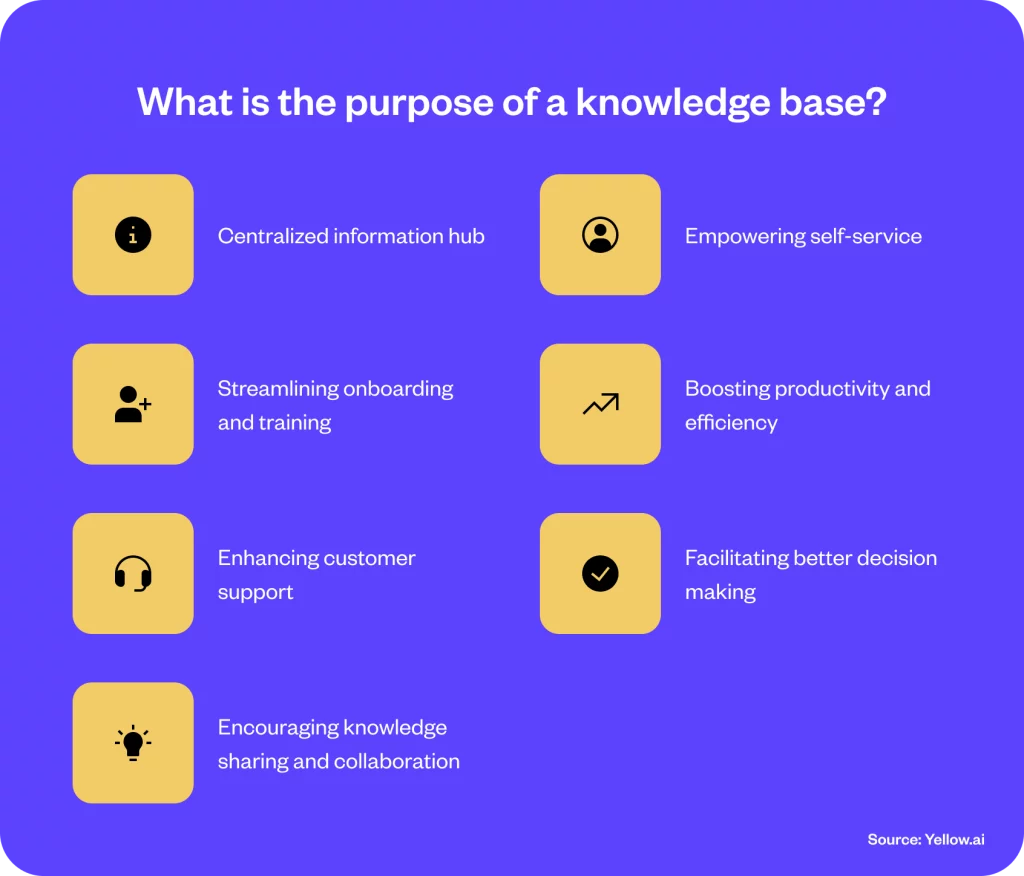
1. Pusat informasi terpusat: Basis pengetahuan bertindak sebagai repositori terpusat tempat semua informasi penting disimpan, diorganisir, dan dipelihara. Sentralisasi ini sangat penting bagi dunia usaha. Hal ini karena memastikan bahwa apakah pelanggan mencari detail produk atau karyawan memerlukan wawasan operasional, basis pengetahuan adalah sumber daya yang tepat. Ini memfasilitasi akses informasi yang cepat dan mudah.
2. Memberdayakan layanan mandiri: Tujuan mendasar dari basis pengetahuan, khususnya basis pengetahuan eksternal, adalah untuk memberdayakan pengguna untuk menemukan solusi secara mandiri. Dengan menyediakan sumber daya yang komprehensif dan mudah dinavigasi, bisnis memungkinkan pelanggan menyelesaikan pertanyaan mereka tanpa bantuan langsung. Itu secara signifikan meningkatkan kepuasan pelanggan dan mengurangi beban kerja dukungan.
3. Menyederhanakan orientasi dan pelatihan: Bagi pemangku kepentingan internal, basis pengetahuan sangat berharga untuk orientasi karyawan baru dan pembelajaran berkelanjutan. Ini menampung materi pelatihan, dokumen prosedur, dan praktik terbaik. Itu membuatnya lebih mudah bagi pendatang baru untuk menyesuaikan diri dan bagi karyawan yang ada untuk memperbarui keterampilan atau pengetahuan mereka.
4. Meningkatkan produktivitas dan efisiensi: Basis pengetahuan meminimalkan waktu yang dihabiskan untuk mencari informasi atau menciptakan kembali roda. Dengan memiliki repositori yang terdokumentasi dengan baik, karyawan dapat dengan cepat mereferensikan informasi yang mereka butuhkan untuk menyelesaikan tugas secara efisien.
5. Meningkatkan dukungan pelanggan: Meskipun basis pengetahuan menawarkan opsi layanan mandiri, basis pengetahuan juga memainkan peran penting dalam mendukung tim layanan pelanggan. Dengan akses ke informasi produk terperinci, panduan pemecahan masalah, dan FAQ, agen dukungan dapat memberikan resolusi yang lebih akurat, konsisten, dan cepat untuk pertanyaan pelanggan.
Terkait baca: Bagaimana cara meningkatkan layanan pelanggan?
6. Memfasilitasi pengambilan keputusan yang lebih baik: Dengan mengkonsolidasikan pengetahuan di satu tempat, basis pengetahuan menyediakan “satu sumber kebenaran”, yang memungkinkan pengambilan keputusan yang lebih baik. Karyawan tidak harus bergantung pada sumber yang terfragmentasi atau menunggu masukan manajerial. Hal ini mengarah pada proses pengambilan keputusan yang lebih terinformasi dan otonom.
7. Mendorong berbagi pengetahuan dan kolaborasi: Basis pengetahuan bukan hanya sekedar repositori namun merupakan platform untuk pertukaran pengetahuan. Hal ini mendorong karyawan untuk menyumbangkan wawasan dan pembelajaran mereka. Hal ini membantu membangun budaya kolaborasi dan perbaikan berkelanjutan.
Mengapa basis pengetahuan penting untuk bisnis Anda
Mengintegrasikan basis pengetahuan ke dalam kerangka bisnis Anda merampingkan operasi dan secara mendasar mengubah bagaimana informasi diakses dan dimanfaatkan di seluruh organisasi Anda. Mari kita jelajahi dua jenis dasar pengetahuan utama dan keunggulannya yang berbeda.
Manfaat basis pengetahuan internal
Basis pengetahuan internal adalah aset yang sangat berharga bagi karyawan Anda. Ini adalah pusat sumber daya yang komprehensif untuk semua pengetahuan organisasi, mulai dari manual prosedural hingga panduan pemecahan masalah. Berikut adalah bagaimana hal itu menguntungkan tim Anda:
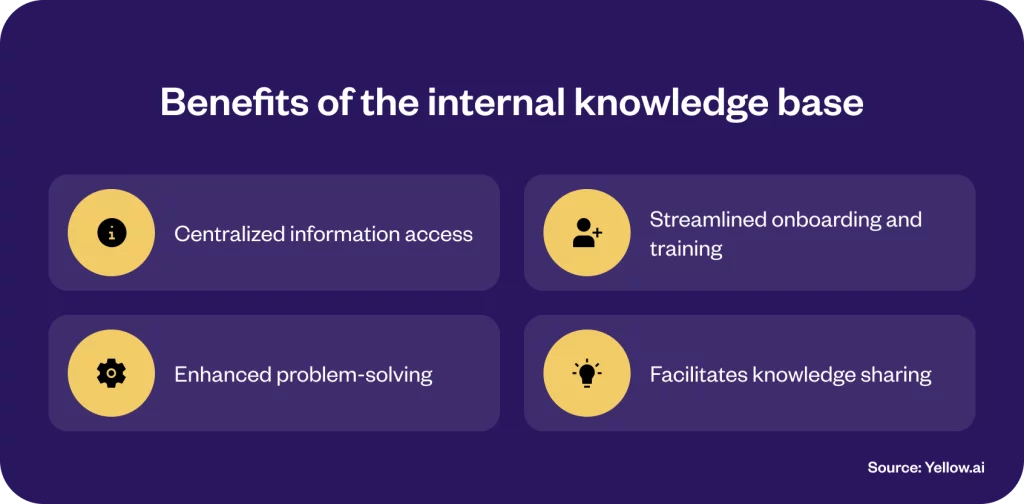
Akses informasi terpusat:
Ini mengkonsolidasikan semua pengetahuan perusahaan menjadi satu lokasi yang mudah dinavigasi. Sentralisasi ini secara signifikan mengurangi waktu yang dihabiskan karyawan untuk mencari informasi, sehingga meningkatkan produktivitas dan efisiensi.
Onboarding dan pelatihan yang disederhanakan:
Kekayaan pengetahuan yang tersedia membuatnya menjadi alat yang ideal untuk orientasi karyawan baru. Mereka dapat secara mandiri mengeksplorasi dokumen rinci, materi pelatihan, dan praktik terbaik, sehingga mempercepat aklimatisasi dan kompetensi mereka dalam perusahaan.
Peningkatan masalah-pemecahan:
Dengan akses langsung ke gudang informasi yang luas, karyawan dapat dengan cepat menemukan solusi untuk masalah yang kompleks tanpa memerlukan dukungan yang luas. Otonomi ini tidak hanya meningkatkan keterampilan pemecahan masalah mereka tetapi juga meningkatkan kepuasan kerja.
Memfasilitasi berbagi pengetahuan:
Mendorong kontribusi dari seluruh organisasi menumbuhkan budaya berbagi pengetahuan. Lingkungan kolaboratif ini tidak hanya memperkaya basis pengetahuan tetapi juga mendukung pembelajaran dan inovasi berkelanjutan.
Manfaat basis pengetahuan eksternal
Secara eksternal, basis pengetahuan melayani pelanggan Anda dengan memberi mereka akses langsung 24/7 ke informasi mengenai produk atau layanan Anda. Alat swalayan ini menawarkan beberapa manfaat utama:
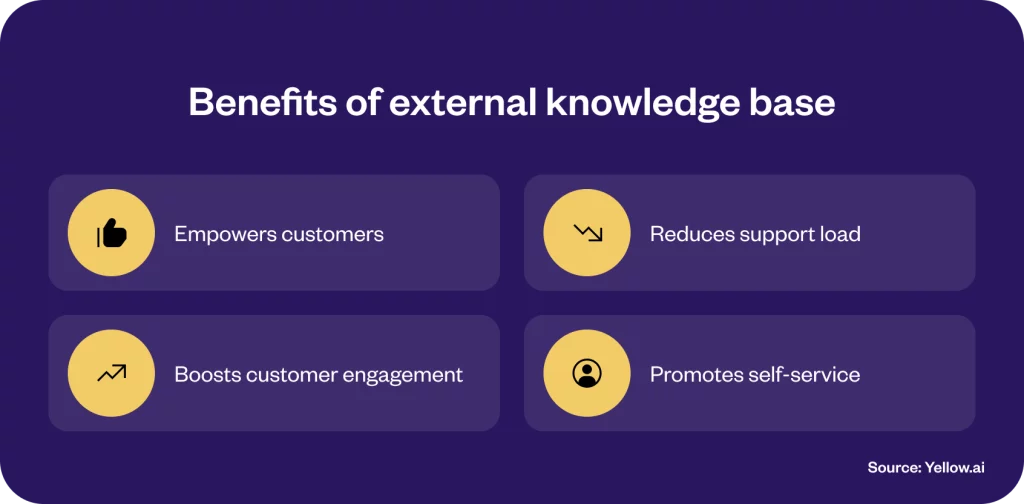
Memberdayakan pelanggan:
Pelanggan dapat menyelesaikan masalah mereka atau menemukan informasi secara mandiri, sesuai keinginan mereka. Pemberdayaan ini secara signifikan meningkatkan kepuasan pelanggan dengan menyediakan bantuan tanpa menunggu bantuan.
Mengurangi beban dukungan:
Dengan mengizinkan pelanggan menjawab pertanyaan mereka sendiri, basis pengetahuan mengurangi volume pertanyaan yang sampai ke tim dukungan Anda. Pengurangan ini membebaskan tim Anda untuk fokus pada masalah yang lebih kompleks yang membutuhkan perhatian pribadi.
Meningkatkan keterlibatan pelanggan:
Basis pengetahuan yang terstruktur secara efisien dan berwawasan luas berdiri sebagai aset utama bagi klien selama interaksi mereka dengan merek Anda. Menawarkan informasi yang komprehensif dan mudah dinavigasi meningkatkan pengalaman pengguna mereka dan juga memperdalam hubungan mereka dengan merek Anda.
Mempromosikan layanan mandiri:
Dalam dunia yang serba cepat saat ini, kemampuan bagi pelanggan untuk melayani diri mereka sendiri tidak dapat dilebih-lebihkan. Basis pengetahuan memenuhi permintaan ini, selaras dengan preferensi pelanggan untuk penyelesaian masalah yang cepat dan efisien.
Bagaimana membangun dan memelihara – basis pengetahuan yang efektif
Membangun dan memelihara basis pengetahuan (KB) yang efektif sangat penting untuk meningkatkan pengalaman pelanggan dan menyederhanakan proses internal dalam bisnis apa pun. Berikut adalah rincian strategi utama untuk mencapai hal ini, memastikan KB Anda menjadi landasan untuk informasi dan dukungan.

1. Identifikasi audiens Anda
Memahami audiens Anda adalah langkah pertama dalam menyusun KB yang memenuhi kebutuhan spesifik mereka. Untuk KB internal, ini berarti menyesuaikan konten agar sesuai dengan peran dan departemen yang berbeda dalam organisasi Anda, dengan fokus pada prosedur, kebijakan, dan wawasan operasional. KB eksternal yang ditujukan untuk pelanggan atau klien harus berkonsentrasi pada panduan produk, langkah-langkah pemecahan masalah, dan FAQ.
Kiat profesional: Lakukan survei rutin atau manfaatkan analitik untuk mengukur kebutuhan audiens Anda yang terus berkembang, memastikan KB Anda tetap relevan dan berharga.
2. Prioritaskan informasi
Tentukan informasi mana yang paling penting bagi audiens Anda. Analisis pertanyaan pelanggan, tiket dukungan, dan umpan balik untuk mengidentifikasi pertanyaan dan masalah umum. Memprioritaskan konten yang membahas area ini memastikan bahwa KB Anda memecahkan masalah aktual dan meningkatkan kepuasan pengguna.
Kiat profesional: Terus perbarui KB Anda berdasarkan tren data dan umpan balik baru untuk menjaga konten tetap relevan dan bermanfaat.
3. Pilih software knowledge base yang tepat
Sangat penting untuk memilih perangkat lunak yang intuitif dan terukur. Cari platform dengan kemampuan integrasi yang kuat yang memungkinkan peningkatan seperti fungi pencarian berbasis AI atau chatbot. Fitur-fitur ini dapat meningkan aksesibilitas dan efektivitas KB Anda secara signifikan.
Kiat profesional: Manfaatkan uji coba gratis untuk mengevaluasi fitur dan kegunaan perangkat lunak secara menyeluruh sebelum membuat keputusan.
4. Pilih kontributor yang berpengetahuan luas
Kumpulkan tim ahli materi pelajaran dari seluruh organisasi Anda. Keahlian mereka yang beragam akan memastikan cakupan komprehensif dari semua topik yang diperlukan. Mendorong kolaborasi antar departemen untuk membina KB yang lebih kaya dan informatif.
Kiat profesional: Ciptakan lingkungan kolaboratif di mana kontributor merasa dihargai dan termotivasi untuk berbagi pengetahuan mereka, meningkatkan kualitas dan kedalaman konten KB Anda.
5. Menerapkan pedoman editorial
Konsistensi dalam nada, gaya, dan format sangat penting untuk KB yang ramah pengguna. Kembangkan panduan gaya yang menentukan elemen-elemen ini dan menguraikan proses pembuatan konten. Ini memastikan pengalaman pengguna yang kohesif di seluruh KB.
Kiat profesional: Gunakan template artikel untuk merampingkan pembuatan konten, menjaga konsistensi sekaligus mengurangi beban kerja pada kontributor.
6. Optimalkan struktur konten dan aksesibilitas
Atur KB Anda dengan cara yang masuk akal bagi pengguna Anda, dengan kategori yang jelas dan judul yang ramah pencarian. Gunakan praktik terbaik SEO, seperti pengoptimalan kata kunci dan struktur URL yang jelas, untuk membuat KB Anda mudah ditemukan secara online.
Kiat profesional: Secara teratur tinjau struktur dan konten KB Anda untuk peningkatan SEO, memastikan bahwa tetap mudah bagi pengguna untuk menemukan dan menavigasi.
5 Contoh basis pengetahuan yang melakukannya dengan benar
Menciptakan basis pengetahuan yang luar biasa (KB) adalah seni yang dikuasai beberapa perusahaan, memberikan nilai yang sangat besar bagi penggunanya dan menetapkan standar industri. Mari kita jelajahi lima contoh perusahaan yang telah merancang basis pengetahuan terbaik, masing-masing dengan fitur unik yang memenuhi kebutuhan audiens mereka secara efektif.
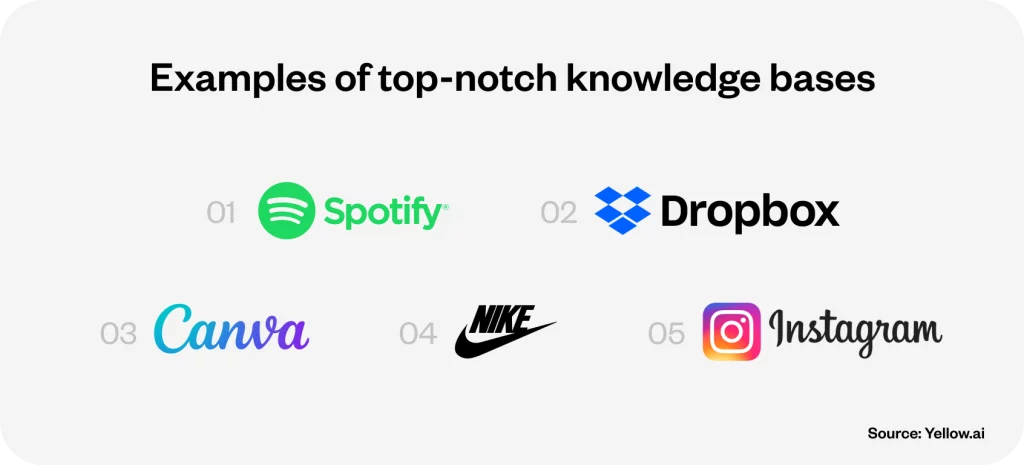
1. Spotify
Basis pengetahuan Spotify adalah perpaduan harmonis antara desain yang ramah pengguna dan informasi yang komprehensif, menjadikannya sumber daya yang tepat bagi pecinta musik dan pengguna aplikasi. Basis pengetahuan mereka menonjol karena organisasinya yang intuitif, memungkinkan pengguna dengan mudah menavigasi kategori dan menemukan solusi untuk masalah mereka. Spotify menggunakan fitur pencarian pelengkapan otomatis, meningkatkan pengalaman pengguna dengan memprediksi kueri berdasarkan data historis, yang secara signifikan mengurangi upaya yang diperlukan untuk menemukan informasi relevan. Pendekatan proaktif terhadap dukungan pelanggan ini menggarisbawahi komitmen Spotify terhadap kepuasan pengguna dan peningkatan berkelanjutan.
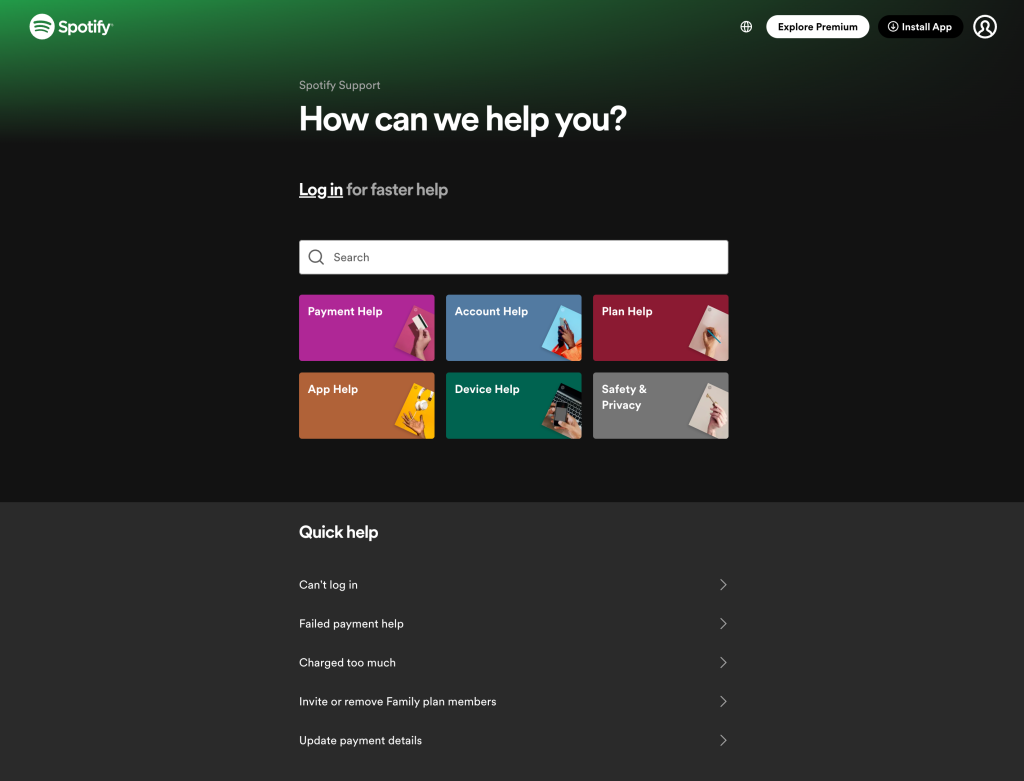
Pembelajaran utama: Menggabungkan fungsi pencarian pelengkapan otomatis di KB Anda dapat meningkatkan pengalaman pengguna secara signifikan dengan membuat pengambilan informasi lebih cepat dan intuitif.
2. Dropbox
Basis pengetahuan Dropbox mencontohkan kejelasan dan kesederhanaan, menampilkan pemahamannya tentang kebutuhan pengguna. Dengan memprioritaskan “Artikel unggulan”, Dropbox menunjukkan komitmennya untuk segera mengatasi masalah umum, yang mencerminkan kesadaran akut terhadap perilaku pelanggan. Basis pengetahuan mereka adalah bukti kekuatan menggabungkan kata-kata yang tepat dan ringkas dengan visual yang bermanfaat, memastikan bahwa pengguna menemukan jawaban yang mereka butuhkan tanpa merasa kewalahan.
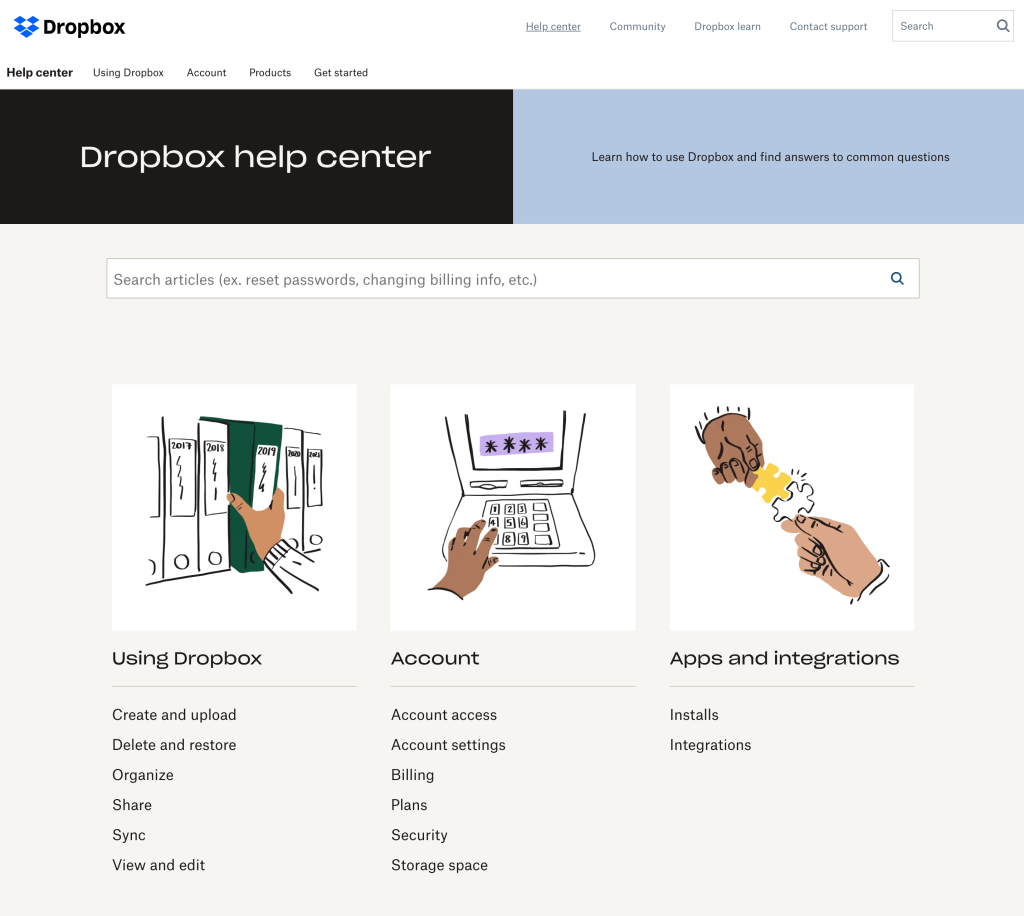
Pembelajaran utama: Analisis data pencarian secara teratur untuk menyoroti topik yang sering dicari sebagai “Artikel unggulan,” membuat basis pengetahuan Anda lebih efisien dan ramah pengguna.
3. Canva
Basis pengetahuan Canva adalah bukti etos desain mereka, menawarkan pengalaman visual yang menarik dan intuitif yang sesuai dengan basis pengguna kreatif mereka. Integrasi grafis visual yang mulus dengan konten tertulis membuat informasi kompleks mudah dicerna. Canva juga memanfaatkan fitur pencarian pelengkapan otomatis, memberikan bantuan yang dipersonalisasi berdasarkan perilaku pengguna dan pencarian sebelumnya. Pendekatan ini tidak hanya memfasilitasi pemecahan masalah yang lebih cepat namun juga meningkatkan pengalaman pengguna secara keseluruhan dengan membuat KB merasa lebih responsif dan disesuaikan dengan kebutuhan individu.
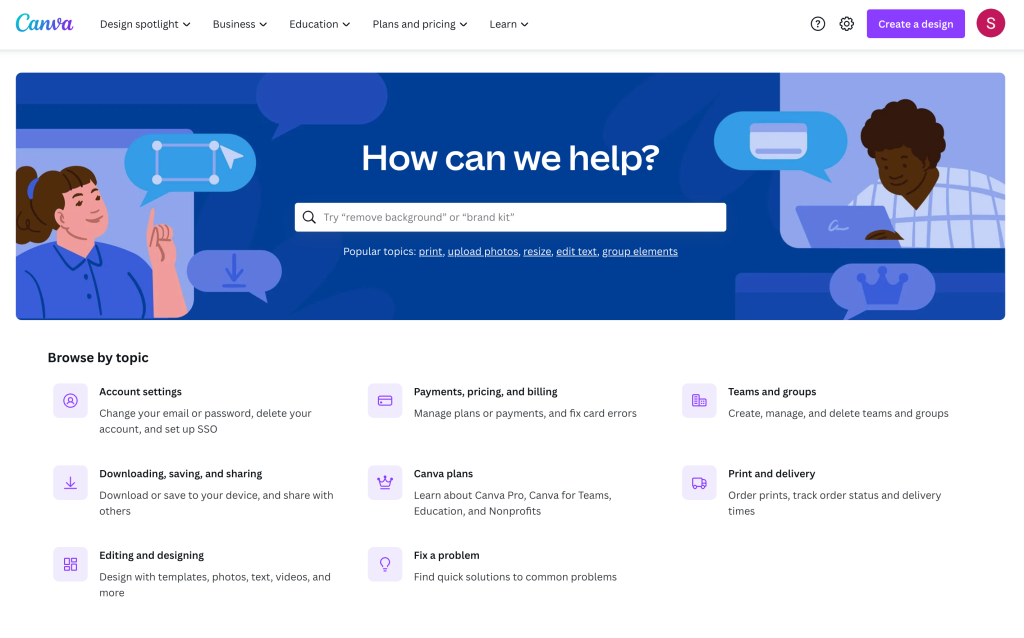
Pembelajaran utama: Tingkatkan KB Anda dengan alat bantu visual untuk melengkapi informasi tekstual, terutama jika produk atau layanan Anda berorientasi pada desain.
4. Nike
Pendekatan Nike terhadap basis pengetahuan mereka, yang dijuluki “Bantuan Cepat”, mencerminkan etos merek mereka dan terhubung dengan audiens atletik mereka pada tingkat yang lebih pribadi. Dengan mengelompokkan pertanyaan umum di garis depan, Nike memastikan akses langsung ke informasi penting, menampilkan pemahaman tentang prioritas pengguna. Organisasi strategis ini, ditambah dengan penggunaan bahasa khusus merek, menekankan pentingnya menyelaraskan nada dan struktur KB Anda dengan identitas merek Anda secara keseluruhan.
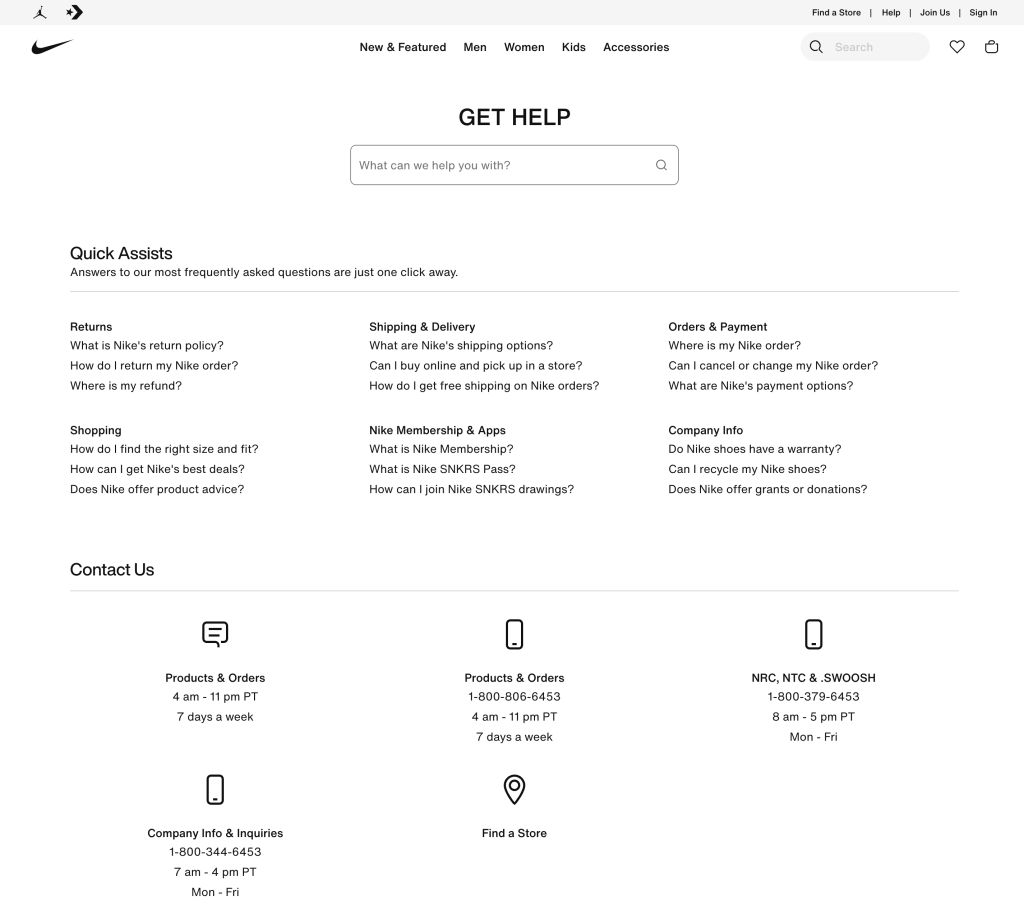
Pembelajaran utama: Sesuaikan terminologi dan kategorisasi KB Anda untuk mencerminkan suara merek Anda, membuat sumber daya terasa seperti perpanjangan alami dari produk atau layanan Anda.
5. Instagram
Basis pengetahuan Instagram memprioritaskan kesederhanaan dan aksesibilitas, mengenali sifat basis penggunanya yang didominasi seluler. Dengan berfokus pada informasi yang paling kritis dan terkini, Instagram memastikan bahwa pengguna dapat dengan cepat menemukan solusi tanpa navigasi yang tidak perlu. Pendekatan minimalis ini menggarisbawahi pentingnya desain KB dalam meningkatkan aksesibilitas, khususnya bagi pengguna seluler, dan menunjukkan bahwa terkadang, lebih sedikit lebih baik.
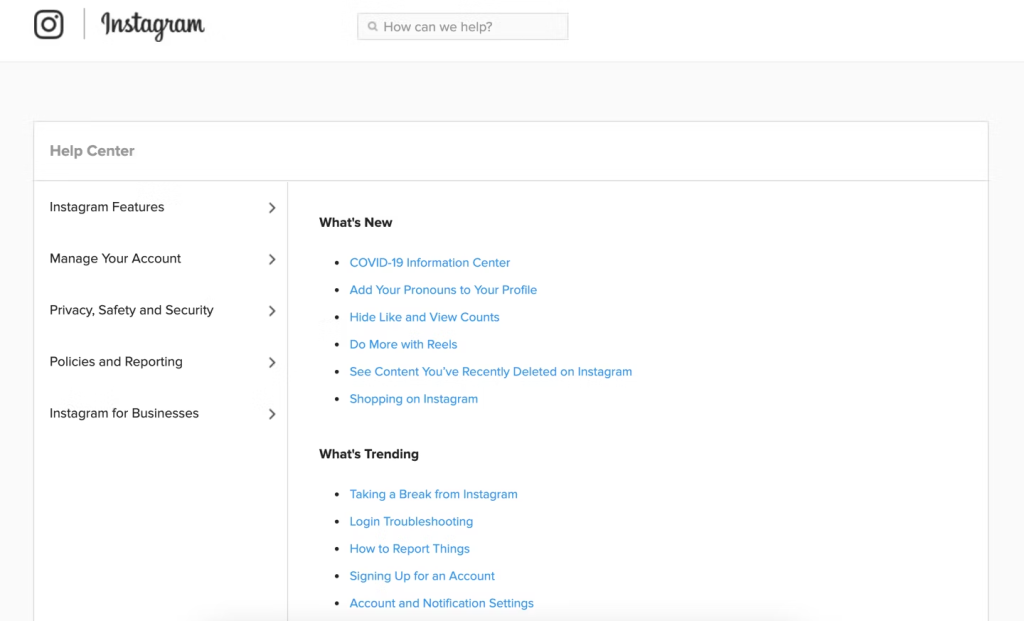
Pembelajaran utama: Rancang KB Anda dengan mempertimbangkan pengguna seluler, pastikan tata letaknya responsif dan konten mudah dinavigasi di layar yang lebih kecil.
Memulai basis pengetahuan baru Anda dengan Yellow.ai
Mengenai basis pengetahuan untuk suatu bisnis, penting untuk mengeksplorasi solusi inovatif yang menyederhanakan proses penciptaan dan manajemen. Yellow.ai menawarkan teknologi mutakhir untuk membantu bisnis membangun basis pengetahuan yang dinamis dan cerdas. Dengan Yellow.ai, penekanannya bukan hanya pada mengumpulkan informasi tetapi membuatnya dapat diakses dan berguna melalui solusi yang didukung AI. Mari kita periksa bagaimana Yellow.ai dapat mengubah basis pengetahuan Anda menjadi aset yang kuat untuk pelanggan dan tim Anda.
- Kurasi konten berbasis AI: Algoritma AI canggih Yellow.ai dapat membantu mengotomatisasi pengumpulan dan pengorganisasian informasi, memastikan basis pengetahuan Anda selalu mutakhir dengan konten terbaru dan paling relevan.
- Pemrosesan bahasa alami (NLP): Dengan teknologi NLP, Yellow.ai meningkatkan kemampuan pencarian basis pengetahuan Anda. Hal ini memungkinkan pengguna untuk menemukan jawaban menggunakan bahasa percakapan dan bukan kata kunci, sehingga membuat prosesnya lebih intuitif.
- AI chatbots untuk bantuan segera: Terapkan chatbots Yellow.ai untuk memandu pengguna melalui basis pengetahuan Anda dengan rekomendasi yang dipersonalisasi, meningkatkan pengalaman layanan mandiri.
- Analisis dan wawasan: Alat analisis komprehensif Yellow.ai memungkinkan Anda memperoleh wawasan berharga tentang bagaimana basis pengetahuan Anda digunakan, mengidentifikasi kesenjangan dalam konten, dan memahami perilaku pengguna.
- Skalabilitas: Seiring pertumbuhan bisnis Anda, platform Yellow.ai berskala bersama Anda, mendukung perpustakaan konten yang berkembang tanpa mengurangi kinerja atau pengalaman pengguna.
Siap untuk meningkatkan strategi manajemen pengetahuan Anda? Pesan demo dengan Yellow.ai hari ini dan temukan perbedaan yang dapat dibuat oleh teknologi cerdas.
Pemikiran terakhir
Sekarang pintar bahwa basis pengetahuan adalah kebutuhan dalam lanskap bisnis yang digerakkan oleh informasi saat ini. Basis pengetahuan yang terpelihara dengan baik dan mudah diakses dapat secara signifikan meningkatkan kepuasan pelanggan, memberdayakan karyawan, dan menyederhanakan operasi. Contoh basis pengetahuan terbaik yang kami jelajahi menggarisbawahi potensi menggabungkan konten hebat dengan antarmuka yang ramah pengguna.
Ketika bisnis terus menavigasi tantangan dalam memberikan layanan yang luar biasa, merangkul solusi inovatif seperti yang ditawarkan oleh Yellow.ai dapat memberikan keunggulan kompetitif. Ingat, tujuannya bukan hanya untuk menyimpan pengetahuan tetapi untuk membuka kekuatannya untuk mendorong hasil bisnis yang lebih baik.
Pertanyaan yang sering diajukan (FAQ)
Dapatkah basis pengetahuan meningkatkan kepuasan pelanggan?
Tentu saja. Basis pengetahuan secara langsung berkontribusi terhadap kepuasan pelanggan dengan memungkinkan pengguna menemukan solusi dengan cepat dan mandiri. Kemampuan layanan mandiri ini mengurangi waktu tunggu untuk mendapatkan dukungan dan memberdayakan pelanggan dengan jawaban langsung, sehingga menghasilkan pengalaman yang lebih positif dan peningkatan kepercayaan terhadap merek Anda.
Tentu saja. Basis pengetahuan secara langsung berkontribusi terhadap kepuasan pelanggan dengan memungkinkan pengguna menemukan solusi dengan cepat dan mandiri. Kemampuan layanan mandiri ini mengurangi waktu tunggu untuk mendapatkan dukungan dan memberdayakan pelanggan dengan jawaban langsung, sehingga menghasilkan pengalaman yang lebih positif dan peningkatan kepercayaan terhadap merek Anda.
Basis pengetahuan berisi campuran konten yang kaya, seperti FAQ, tutorial langkah demi langkah, dokumentasi produk, kiat pemecahan masalah, ikhtisar kebijakan, dan bahkan penelusuran video. Beraneka ragam ini dirancang untuk membekali pengguna dengan jawaban terperinci dan mudah diikuti yang khusus memenuhi pertanyaan mereka.
Bagaimana Anda mempertahankan basis pengetahuan?
Mempertahankan basis pengetahuan melibatkan tinjauan rutin, pembaruan, dan penambahan konten baru untuk mencerminkan perubahan dalam produk, layanan, atau kebijakan. Ini juga mencakup analisis umpan balik pengguna dan data interaksi untuk mengidentifikasi area yang perlu ditingkatkan dan memastikan semua informasi akurat dan mudah dipahami.
Alat apa yang digunakan untuk membuat basis pengetahuan?
Alat untuk membuat basis pengetahuan berkisar dari sistem manajemen dokumen sederhana hingga platform canggih yang dilengkapi dengan AI dan kemampuan pembelajaran mesin untuk kurasi konten dinamis, optimalisasi pencarian, dan analisis interaksi pengguna. Fitur utama yang harus dicari termasuk antarmuka pembuatan konten intuitif, analitik, dan integrasi dengan perangkat lunak dukungan pelanggan yang ada.
Bagaimana basis pengetahuan mendukung layanan mandiri?
Basis pengetahuan mendukung layanan mandiri dengan menyediakan sumber daya komprehensif di mana pelanggan dapat mencari dan menemukan jawaban atas pertanyaan mereka sendiri. Fungsi pencarian tingkat lanjut, kategorisasi, dan antarmuka yang ramah pengguna memfasilitasi navigasi yang mudah, sehingga lebih mudah bagi pengguna untuk menyelesaikan masalah mereka tanpa memerlukan bantuan langsung dari dukungan pelanggan.





















